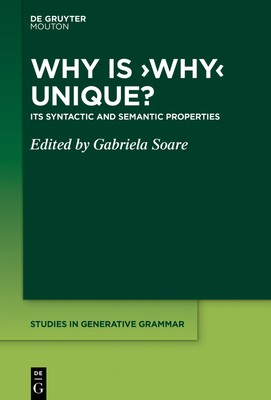
- We will send in 10–14 business days.
- Publisher: Walter de Gruyter
- ISBN-10: 3110675110
- ISBN-13: 9783110675115
- Format: 15.6 x 23.4 x 2.2 cm, hardcover
- Language: English
- SAVE -10% with code: EXTRA
Why Is 'Why' Unique? (e-book) (used book) | bookbook.eu
Reviews
Description
Why is 'Why' Unique? Its Syntactic and Semantic Properties considers the behaviour of this peculiar wh-element across many different languages, including Ewe, Trevisan, Italian, Basque, German, Dutch, Cantonese, Mandarin, English and Hebrew. In ten original chapters, the authors explore various aspects of why-questions, such as the way why interacts with V2 constructions in Basque, with a subject clitic in Trevisan or how its morpho-syntactic make-up determines its merge position in Ewe, to mention but a few. Furthermore, a clear-cut distinction is established between high and low reason adverbials which are subsequently examined in why-stripping environments in Dutch.
Beyond why proper, the book explores a special class of wh-expressions in some in-situ languages which give rise to unexpected why-construals with a touch of whining force. The objective is to explain the unusual syntactic position of these wh-expressions as well as their association with peculiar pragmatics. The questions are addressed for Cantonese: are what-initial sentences genuine questions? To what extent are Cantonese what-initial sentences similar to how-initial sentences in Mandarin? Beside these what-as-why questions, a special class of rhetorical questions, the doubly-marked interrogatives in Hebrew, come under scrutiny.
Why is 'why' unique also concerns the interface with prosody and several experimental studies investigate precisely this aspect.
EXTRA 10 % discount with code: EXTRA
The promotion ends in 15d.01:03:39
The discount code is valid when purchasing from 10 €. Discounts do not stack.
- Publisher: Walter de Gruyter
- ISBN-10: 3110675110
- ISBN-13: 9783110675115
- Format: 15.6 x 23.4 x 2.2 cm, hardcover
- Language: English English
Why is 'Why' Unique? Its Syntactic and Semantic Properties considers the behaviour of this peculiar wh-element across many different languages, including Ewe, Trevisan, Italian, Basque, German, Dutch, Cantonese, Mandarin, English and Hebrew. In ten original chapters, the authors explore various aspects of why-questions, such as the way why interacts with V2 constructions in Basque, with a subject clitic in Trevisan or how its morpho-syntactic make-up determines its merge position in Ewe, to mention but a few. Furthermore, a clear-cut distinction is established between high and low reason adverbials which are subsequently examined in why-stripping environments in Dutch.
Beyond why proper, the book explores a special class of wh-expressions in some in-situ languages which give rise to unexpected why-construals with a touch of whining force. The objective is to explain the unusual syntactic position of these wh-expressions as well as their association with peculiar pragmatics. The questions are addressed for Cantonese: are what-initial sentences genuine questions? To what extent are Cantonese what-initial sentences similar to how-initial sentences in Mandarin? Beside these what-as-why questions, a special class of rhetorical questions, the doubly-marked interrogatives in Hebrew, come under scrutiny.
Why is 'why' unique also concerns the interface with prosody and several experimental studies investigate precisely this aspect.


Reviews